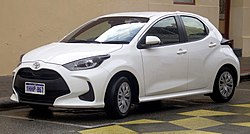Japan
The Japanese market Yaris was launched in 10 February 2020. It marked the debut of the Yaris nameplate in the market, as its predecessors were badged as Vitz. The rebrand was attributed to a sharp drop in sales, and as an effort to expand its middle-aged customer base. [17] The other reasons of the name change is its WRC popularity and the unification of Toyota sales network in Japan. Prior to this generation, the Vitz was an exclusive model of the Netz Store dealerships, while the newer Yaris is positioned as a widely available compact car since the unification of Japanese dealership line-up in May 2020. [18]
The Japanese-built XP210 series Yaris retained the 1,695 mm (66.7 in) width of the previous generation Vitz in order to stay in the "compact car" classification of Japanese government dimension regulations. Three powertrain options are offered, ranging from the base 1.0-litre petrol, 1.5-litre petrol and 1.5-litre petrol hybrid engines. Four-wheel drive is available as an option for 1.5-litre models, with the hybrid version received an "E-Four" electric four-wheel drive system. 6-speed manual transmission is only available for the 1.5-litre conventional petrol engine. Trim levels offered are X "B package", X, G, and Z. [1]
Since February 2023, a modified version of the XP210 series Yaris is sold by Mitsuoka as the Mitsuoka Viewt Story, which is a fourth-generation Viewt. It replaced the previous Nissan March-based Viewt. Like its previous iterations, its design was inspired by the Jaguar Mark 2. [19]
The facelifted Japanese market Yaris was released on 17 January 2024 with redesigned grille. [20]
The special edition Yaris Z "Urbano" was released in early 2025. Like the regular Z grade, the Urbano is offered with either 1.5-litre gasoline or hybrid with the choice of front-wheel drive or all-wheel drive. The Z "Urbano" comes with all black color of front and rear emblems, roof, door handles, side window molding, and roof spoiler. It also has Urbano fender emblem and gloss black 16-inch alloy wheels. Other special features are "Urbano" logo projection illumination, as well as "Urbano" steering wheel emblem, floor mats, and scuff plates. [21]
2020 Toyota Yaris Hybrid (MXPH10, Japan)
Toyota Yaris 1.5 AWD (MXPA15, Japan)
Interior (Japan)
2024 Facelift Toyota Yaris Z (MXPA10, Japan)
2024 Facelift Toyota Yaris Hybrid Z (MXPH14, Japan)
Interior (facelift, MXPH14, Japan)
Australasia
The XP210 series Yaris was revealed for Australia and New Zealand in June 2020, with sales starting from August 2020. Sourced from Japan, the Yaris for these markets received the 1.5-litre petrol engine both in conventional and hybrid configuration, with the latter being positioned as the replacement to the Prius c(Aqua). The Australian line-up consists of three trim levels, which are Ascent Sport, SX and ZR. [22] [23]
Non-hybrid Yaris hatchbacks were no longer offered in Australia since March 2024. [24]
2021 Yaris Ascent (MXPA10, Australia)
2021 Yaris Ascent (MXPA10, Australia)
Europe
For the European market, specifications were detailed in July 2020. It is available with the 1.5-litre petrol hybrid engine, while certain markets in the region also received the 1.0-litre and 1.5-litre conventional petrol engines. [25] [26] Production commenced at Toyota Motor Manufacturing France in Onnaing since 6 July 2020. [27] It is also produced by Toyota Motor Manufacturing Czech Republic in Kolín since November 2021. [3]
In August 2021, a two-seater van version of the Yaris Hybrid was released in Spain as the Yaris Hybrid ECOVan. [28]
In December 2021, the GR Sport trim was introduced. [29] This includes revised suspension tunings, increased body rigidity, and electric power steering readjustment.
An uprated 1.5-litre petrol hybrid engine option with a combined system output of 96 kW (129 hp; 131 PS) was made available on 30 May 2023, marketed as the 'Hybrid 130' while the older hybrid option was named 'Hybrid 115'. [30] [31]
The Yaris Hybrid-based Mazda2 Hybrid is produced from December 2021 and went on sale in 2022 alongside the older Mazda-built, regular petrol-powered DJ model. [32] [33] [34]
Yaris GR Sport Hybrid (MXPH11, Germany)
Yaris GR Sport Hybrid (MXPH11, Germany)
Yaris Hybrid 130 (2023 refresh)
Yaris Hybrid 130 (2023 refresh)
2022 Mazda2 Hybrid
2024 Mazda2 Hybrid
2024 Mazda2 Hybrid















